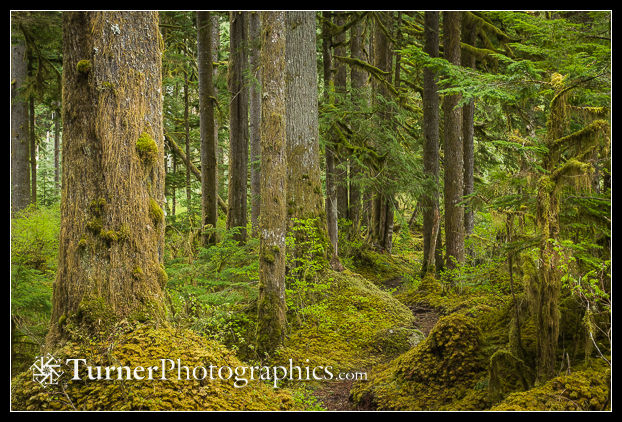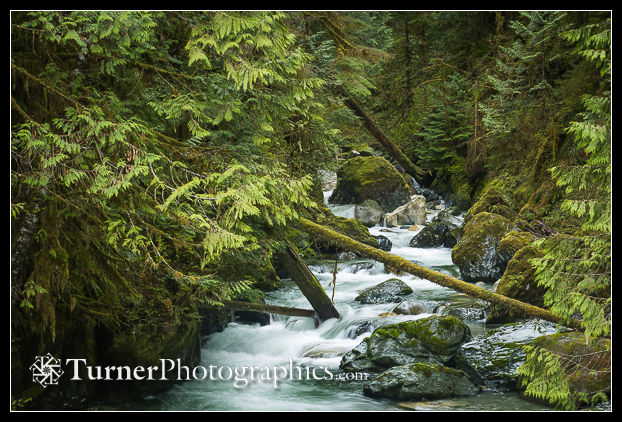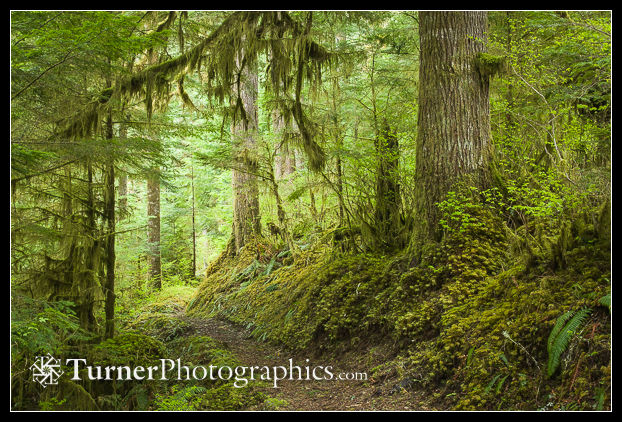A Visit to Noisy Creek

April hikes in the North Cascades have to be at lower elevations unless you want to break out your snowshoes or skis. On a rainy Sunday it made sense for my friend Brian and me to choose the East Bank Baker Lake Trail and head to Noisy Creek. Neither of us had hiked this section of trail before.
At only 800 feet elevation, spring was in full swing along the trail. We inhaled deeply as we entered the woods, sucking in the sweet scent of moist humus and conifers. Much of the forest is old growth, the usual mix of Douglas-fir, western hemlock, and western redcedar, the understory a tangle of mossy logs and thickets of vine maples, salmonberries, and huckleberries. Without a trail it would be tough bushwhacking.
![Old-growth Douglas-fir [Pseudotsuga menziesii]. Mt. Baker-Snoqualmie National Forest East Bank Baker Lake Trail, WA. © 2017 Mark Turner Old-growth Douglas-fir](/wp-content/uploads/2017/04/Turner_A30A3552.jpg)
Fortunately, the trail is good and the walking easy, with only a little up and down as the route skirts the lake. We decided to hike briskly to Noisy Creek and take our time on the way back. That way we could get both a workout and a relaxed amble to enjoy the forest.

There’s a lot of water flowing down from the rugged mountains above. Some of the streams have bridges, but others are small enough to wade across. After a very wet winter every creek was running full. It wasn’t just Noisy Creek that made a lot of noise — every stream had its own distinct sound, from the gentle trickle of water flowing through mossy channels to the cacophonous roar from Blum Creek, Hidden Creek, and other unnamed streams. We paused to listen, to savor, to enjoy.
We examined ferns just beginning to unfurl their fronds — tightly curled lady and wood fern fiddleheads, fuzzy inverted U forms of the sword ferns, and delicate pendulous beginnings of the maidenhairs. There were others, but without a field guide we couldn’t be sure what we were seeing.
![Oval-leaf Huckleberry blossoms and foliage detail [Vaccinium ovalifolium]. Mt. Baker-Snoqualmie National Forest East Bank Baker Lake Trail, WA. © 2017 Mark Turner Oval-leaf Huckleberry blossoms and foliage.](/wp-content/uploads/2017/04/Turner_A30A3581.jpg)
If the pollinators do their thing and the flowers turn to fruit, it’s going to be a banner year for oval-leaf huckleberries. They’re one of the first to bloom, and the shrubs were dense with flowers, which are about the same size and shape as the fruit.
![Stairstep Moss [Hylocomium splendens]. Mt. Baker-Snoqualmie National Forest East Bank Baker Lake Trail, WA. © 2017 Mark Turner Stairstep Moss [Hylocomium splendens].](/wp-content/uploads/2017/04/Turner_A30A3557.jpg)
If you’re a moss lover, this is the trail for you. The ground, fallen logs, and many tree trunks were covered in a rich diversity of mosses (lichens, too). We could easily recognize stairstep moss, Hylocomium splendens. Each year’s new growth rises above the previous year’s leaves on this very common species. It’s a golden yellow-green and forms dense carpets. We could have spent hours with a field guide and hand lens trying to identify all the different species of mosses and liverworts along the trail.
The advertised feature of the Noisy Creek trail, which heads upstream from Baker Lake, is a gigantic Douglas-fir, known as ‘Big Doug.’ It’s not far up the side trail and it’s definitely a big tree. What’s unusual is that it’s about the only Douglas-fir in a sea of western redcedars. Unfortunately, Big Doug is getting loved to death by hikers going right up to it and trampling the mosses and ferns and bunchberry and twinflower that should have been at Big Doug’s feet. The soil around the tree is bare from all the visitors and I didn’t bother to photograph it.

We continued up the Noisy Creek trail until we’d gained about 750 feet from the lake, climbing steeply. We kept expecting to find a somewhat level bench on the hillside, or that the trail would come down to the creek itself, but we gave up before we found either. You hear Noisy Creek in the distance, but except for a single viewpoint high above the stream you never see it.
After our climb up the side trail, we headed the short distance down to Baker Lake and the Noisy Creek campsites for lunch. The sun almost came out and we enjoyed our lunch on the lakeshore. Then I pulled my camera from my pack and spent more than an hour exploring the forest around the camp, which is where I made most of my images that day.
![Salmonberry blossom [Rubus spectabilis]. Mt. Baker-Snoqualmie National Forest East Bank Baker Lake Trail, WA. © 2017 Mark Turner Salmonberry blossom](/wp-content/uploads/2017/04/Turner_A30A3598.jpg)
The East Bank Baker Lake trail is suitable for hikers of all ages and abilities as long as you’re OK with a few rock-hopping creek crossings (or just wade in the shallow water). It’s a shady hike so it will be nice on a summer’s day, too. But spring has to be the best, especially since we saw only one other party the whole day and they were only as far along as Blum Creek, just a short distance from the swinging bridge.

Reach the East Bank Baker Lake trailhead by driving to the end of the Baker Lake road off Hwy 20 near Concrete (Northwest Forest Pass required for parking at the trailhead). The trail heads up the Baker River and not far along splits from the Baker River trail (another nice choice), crosses a suspension bridge over the river, and heads down the lake. If you’ve got the energy you can hike all the way to the other end of the lake, some 14.5 miles, but be aware that the bridge over Anderson Creek at the south end is currently out and reportedly impassable.

